Contents
Phlox Blue Paradise was obtained by Piet Oudolf in 1995 in Holland. This is a beautiful ornamental plant with flowers of a dark blue or purple hue. This variety of phlox is characterized by high growth rates and good winter hardiness.
Description of Blue Paradise phlox
Panicled phlox Blue Paradise is a herbaceous culture about 1 m high. Its stems are strong, with a dark tint. The diameter of the Blue Paradise panicled phlox bush can reach 120 cm. The spreading of the erect stems is medium. Plant supports are not required.
Phlox Blue Paradise leaves have an elongated shape with pointed ends. They can reach a length of 10-12 cm, a width of about 2-3 cm. On both sides, the leaves are smooth, dark green in color, the pattern of the veins is clearly distinguished.
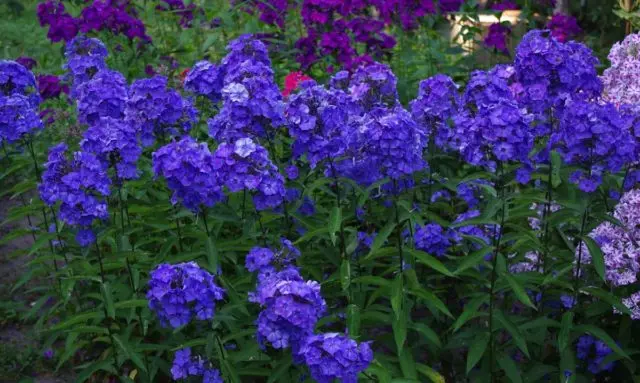
Phlox Blue Paradise flowers have a different shade depending on the light
The variety is sun-loving, but can grow in partial shade. Direct sunlight is recommended, but should not be too intense.
The growth rate of Blue Paradise phlox is good, but the rhizome needs to be divided after several seasons. The frost resistance of the plant corresponds to the 4th zone, which allows it to withstand winters with temperatures up to -35 ° C. It can be grown in any regions where in August there is no cooling below + 15 ° С.
Features of flowering phlox Blue Paradise
Phlox paniculata Blue Paradise belongs to the European group. Flowering occurs in August-September, lasts a long time, from 1,5 to 2 months. In sunny areas, the flowering time is slightly reduced (up to 4-5 weeks), but the splendor of flowers is much greater. Plants grown in the shade bloom even less (no more than 3 weeks).
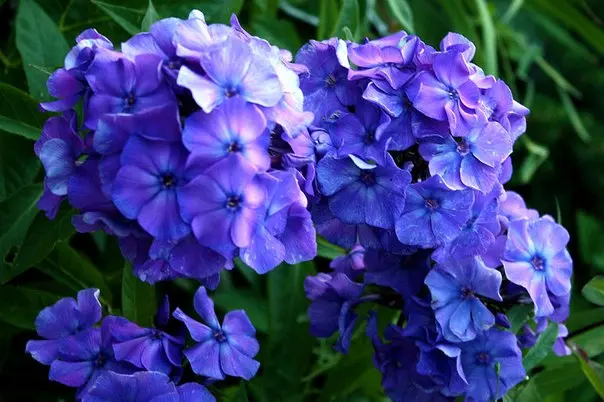
Panicle-type inflorescence, large size (up to 20 cm in diameter), having a round or oval shape
Flowers with a diameter of 25 to 50 mm, open at different times, due to which such a duration of flowering is ensured. Phlox Blue Paradise petals are slightly wavy, the color changes depending on the light. In bright sunlight, it becomes a rich lilac, in cloudy weather or in phlox growing in the shade, it becomes a bright blue-blue with purple edging.
Application in design
In landscape gardening, Blue Paradise phloxes are effective as an element of a flower array. When densely planted, they are able to create a solid carpet of all kinds of blue and lilac shades.

In summer cottages and in small gardens, the variety is used to create high borders around paths.
But design applications are not limited to these two primitive roles. Blue Paradise phloxes look great against coniferous plants, while solid blue-violet plantings can be diluted or surrounded by undersized elements of warmer shades (for example, pink or purple stonecrops). Also, flowers look good as a frame around small artificial ponds.
As a central element of the composition, Blue Paradise phlox can be used in flowerbeds with a “undersized” population or annuals that have bright colors (marigolds, lobelia, etc.)
The culture is combined with many other flowers: asters, astilbes, daylilies, verbena, marigolds, hostas, geleniums.
The plant can be grown in pots or flowerpots located outdoors. It is even allowed to place flowers in a container at home. But in both cases, one should not forget that the root system grows very quickly, which will require a change of container or regular division of the rhizome. In addition, with this method of growing, Blue Paradise phloxes need more frequent watering.
Methods of reproduction
Mostly for phlox panicled Blue Paradise, vegetative propagation is used. Seed does not have the necessary efficiency, does not guarantee the inheritance of the properties of the mother plant and cannot give so much seed.
The easiest way to propagate is by dividing the bush. After 3-4 years, the rhizome grows very strongly and loses its growth rate. Usually it is completely divided into separate roots and seated.
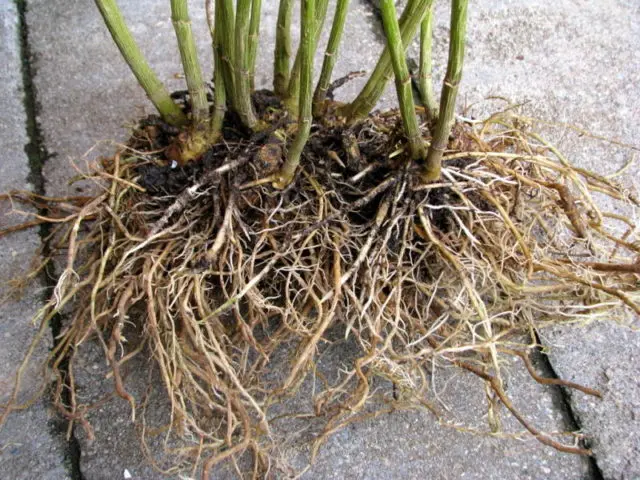
By division, up to 5-8 bushes are obtained from one maternal
But the most effective way, which gives the largest amount of seed, is propagation by stem cuttings. The advantage of this technique is that they can be planted not only in greenhouse conditions, but also directly in open ground. The highest percentage of survival (90-100%) is obtained from cuttings planted from May to July, they are harvested before planting.
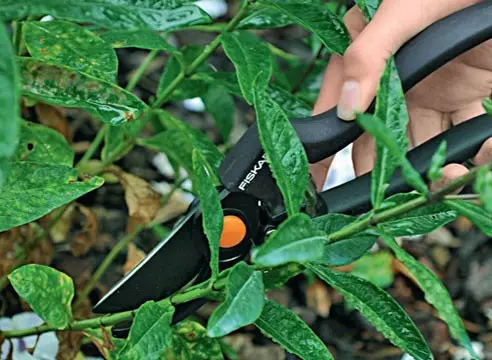
Cutting planting material from the stems – the first stage of reproduction
Propagation by leaf cuttings or spring growth shoots is actually a variation of the previous method. You can get more seed with this, but there are certain details that you need to remember.
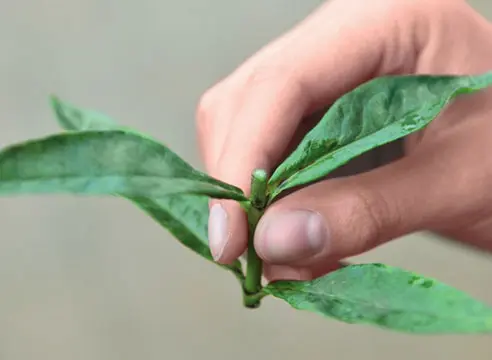
The stalk usually consists of two nodes, each of which has adult leaves.
This method is less effective (50-60% survival rate) and requires the use of greenhouses for preliminary rooting.
Rules of landing
The timing of planting Phlox Blue Paradise depends on the type of seed. Seeds are planted in a greenhouse at the end of March. Acquired seedlings or seed obtained from cuttings and divided rhizomes are best transferred to the ground in late summer or autumn. As an exception, planting in spring or summer is allowed, but at the same time, the growth of phloxes is significantly delayed, and you may not wait for flowering next year.
As already noted, the plant is photophilous, therefore, sunny areas are chosen for its planting.
The soil should be fertile, well-moistened and loose. The best option is nutritious medium loams with neutral or weak acidity (pH from 6,5 to 7, but not higher). Spring planting involves soil preparation in the fall, autumn planting about a month before the planting date.
Site preparation is carried out according to the standard scheme:
- The site is cleared of weeds and leveled.
- Fertilizers are applied, including lime, peat and humus.
- Baking material is introduced (on loams – sand, on sandstones – manure or clay).
- After fertilizing, the site is again dug up to a depth of 10-15 cm and leveled.
After that, the plot is watered abundantly and left alone until planting.
No seed preparation is required. Planting can be done immediately after purchasing or receiving seedlings.

Holes with a depth equal to the size of the root system are dug at a distance of 50 cm from each other.
After planting, the plants are sprinkled with soil and lightly tamped. The first watering is carried out after three days. In the next two weeks, it is carried out daily.
Aftercare
Watering is carried out as the top layer of the soil dries. Since Phlox Blue Paradise belongs to plants that are deficient in moisture, its watering rates are quite large, at least 20 liters per 1 sq. m of area occupied by the plant.
After watering, it is necessary to loosen the soil to a depth of 5 cm, since the culture reacts very poorly to moisture stagnation in the upper soil layer. In addition, at the same time, this procedure allows you to get rid of weeds that significantly inhibit the growth of phlox. Mulching culture is not practiced.
The first dressing of Phlox Blue Paradise is performed after the snow has melted. It includes a complex fertilizer for ornamental plants with a large amount of nitrogen. The second is produced during budding (May-June). It consists of potassium-phosphorus compounds, while the proportion of nitrates should be minimal. The best option in this case would be a mullein solution with the addition of wood ash.
The third top dressing (with a lot of potassium) is done at the end of June. The plant is fed with similar compounds for the fourth time in a month.
The last fertilization is done after flowering, at the end of September. In this case, complex fertilizer for ornamental crops is again used.
Pruning of the plant is done after the flowering period is over. At the same time, the stems are completely cut off, leaving no more than 10-12 cm above the ground. After the procedure, the soil around the bush is treated with insecticides and fungicides. The cut stems and leaves are burned.
Preparation for winter
Preparation for winter consists in mulching the space around the plant within a radius of 30 cm with a layer of crushed horse manure. It is allowed to lay some covering material on top of the mulch layer that allows air to pass through.
Pests and diseases
The main pest of phlox is the nematode, a microscopic worm with a thin filamentous body. It lives in the stems of the plant and feeds on its juice.
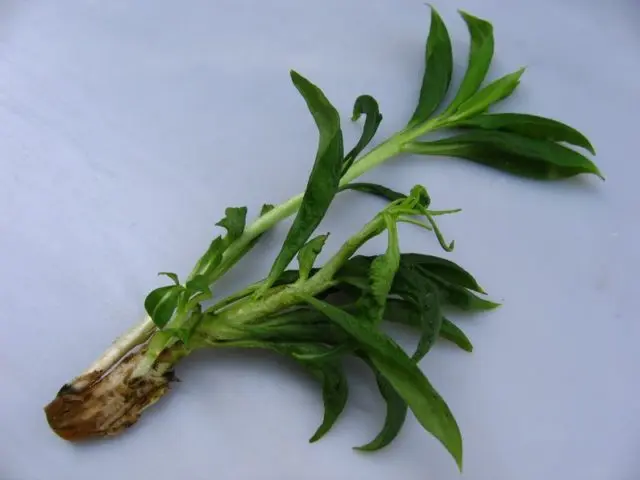
Shoots affected by the nematode lose their shape, and the leaves on them curl
The main way to deal with this worm is preventive. At the beginning of autumn, the tops of the weakly affected shoots of the Blue Paradise phlox should be removed, and the stems severely damaged by the pest should be completely cut out and burned.
In addition, it is recommended to add a mixture of manure and straw to the wells at the planting stage. This composition forms colonies of fungi that are harmless to the plant, but inhibit the development of nematodes. Each subsequent year, it is recommended to mulch the soil around the plant with the same mixture in early spring.
Phlox Blue Paradise can infect various types of insects, the most dangerous of which are golden and shaggy bronzes.
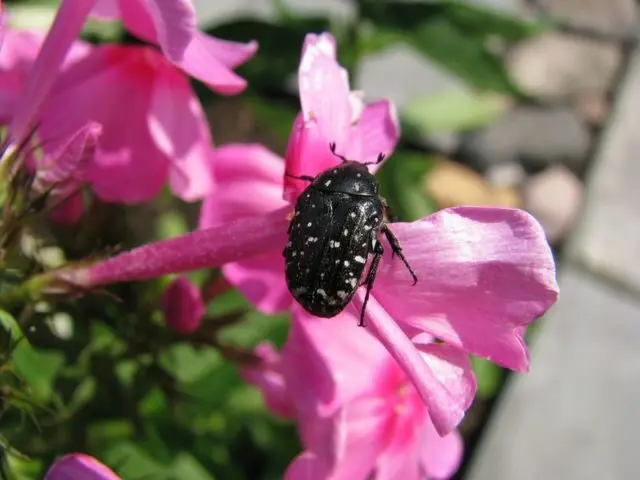
Bronzovki eat plant buds and young flowers
The fight against this pest is carried out exclusively by mechanical methods – collection and destruction. Against other insects that are potentially dangerous to the plant, preventive treatment with insecticides is used in early May.
Conclusion
Phlox Blue Paradise is a beautiful ornamental plant with large inflorescences of a blue-violet hue. Despite the relative unpretentiousness and high winter hardiness, for beautiful flowering, it requires regular and systematic care, which consists in watering and top dressing. The culture is widely used in landscape design, and with the appropriate container size, it can even be used in indoor floriculture.









